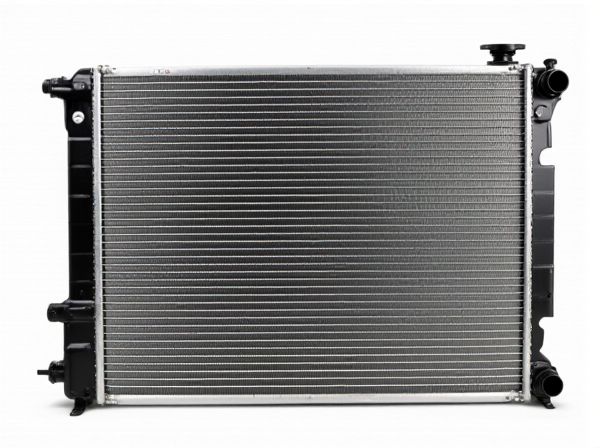
Photo illustration: Straight Fin Radiator vs Louvered Fin Radiator
Straight fin radiators provide efficient heat transfer with a simple, uniform design ideal for steady airflow and low maintenance environments. Louvered fin radiators feature angled fins that disrupt airflow, increasing turbulence and enhancing heat dissipation, making them suitable for applications requiring higher thermal performance. Understanding the difference helps you select the optimal radiator type to maximize cooling efficiency in your system.
Table of Comparison
| Feature | Straight Fin Radiator | Louvered Fin Radiator |
|---|---|---|
| Design | Flat, parallel fins | Angled, slotted fins |
| Heat Dissipation | Moderate efficiency | Higher efficiency due to increased turbulence |
| Airflow | Straight, less turbulent | Enhanced airflow mixing |
| Durability | Simple structure, durable | More complex, slightly less durable |
| Manufacturing Cost | Lower cost | Higher cost due to complexity |
| Application | Standard vehicles, moderate cooling needs | High-performance vehicles, heavy-duty cooling |
Introduction to Radiator Fin Types
Straight fin radiators feature parallel, flat metal fins that maximize surface area for efficient heat transfer in HVAC systems. Louvered fin radiators incorporate angled, perforated fins designed to increase turbulence in airflow, enhancing heat dissipation. Understanding these radiator fin types is essential for optimizing thermal performance in residential and commercial heating and cooling applications.
Overview of Straight Fin Radiator Design
Straight fin radiators feature parallel, evenly spaced fins that maximize surface area for efficient heat transfer in HVAC systems. This design allows for uniform airflow and reduced pressure drop, enhancing overall thermal performance and energy efficiency. Typically constructed from aluminum or copper, straight fin radiators are widely used in residential and commercial applications due to their simplicity and reliability.
Overview of Louvered Fin Radiator Design
Louvered fin radiators feature fins bent into angled or curved shapes that enhance airflow and heat transfer efficiency by increasing turbulence around the surface. This design promotes better convection and faster heat dissipation compared to straight fin radiators with flat, perpendicular fins. The louvered fin arrangement is widely used in HVAC systems and automotive cooling to optimize thermal performance while maintaining compact dimensions.
Thermal Efficiency Comparison
Straight fin radiators feature parallel, flat fins that facilitate direct airflow, optimizing heat transfer through convection and conduction. Louvered fin radiators incorporate angled or perforated fins to increase surface turbulence, enhancing thermal exchange by disrupting boundary layers. The louvered design typically achieves higher thermal efficiency, improving heat dissipation rates by 10-15% compared to straight fin models under equivalent operating conditions.
Airflow Characteristics and Pressure Drop
Straight fin radiators provide a more direct airflow path with lower turbulence, resulting in reduced pressure drop and efficient heat dissipation in applications requiring high airflow rates. Louvered fin radiators introduce angled fins that disrupt the airflow, increasing turbulence to enhance heat transfer but causing a higher pressure drop compared to straight fin designs. The choice between straight and louvered fins depends on balancing airflow efficiency and thermal performance, particularly in HVAC systems and automotive cooling where pressure drop critically affects system energy consumption.
Dirt and Debris Accumulation
Straight fin radiators tend to accumulate more dirt and debris due to their flat surface, which allows particles to settle easily and obstruct airflow. Louvered fin radiators feature angled fins designed to improve air turbulence and reduce the buildup of particles, enhancing heat transfer efficiency. The reduced accumulation of debris in louvered fin radiators results in lower maintenance requirements and prolonged operational performance.
Manufacturing Complexity and Cost
Straight fin radiators feature simpler manufacturing processes due to their uniform fin design, resulting in lower production costs and ease of mass production. Louvered fin radiators require intricate stamping and bending operations to create angled fins, increasing manufacturing complexity and material waste. The added complexity of louvered fins typically leads to higher costs but may improve thermal performance, balancing cost against efficiency.
Application Suitability
Straight fin radiators offer efficient heat transfer and are well-suited for applications requiring compact size and uniform airflow, such as HVAC systems in residential buildings. Louvered fin radiators enhance turbulence and heat dissipation, making them ideal for industrial cooling systems or environments with high ambient temperatures. Selection depends on the specific heating or cooling demands, airflow characteristics, and spatial constraints of the application.
Maintenance and Longevity Considerations
Straight fin radiators typically require less frequent cleaning due to their simpler design, minimizing dust accumulation and easing maintenance efforts. Louvered fin radiators, while offering improved heat transfer efficiency, often demand more regular inspections and cleaning to prevent clogging of angled fins that can trap debris. Both types benefit from routine maintenance to ensure longevity, but straight fins generally provide a longer service life with lower maintenance costs.
Choosing the Right Fin Type for Your Needs
Straight fin radiators offer higher thermal conductivity and are ideal for applications requiring efficient heat transfer in compact spaces, while louvered fin radiators enhance airflow turbulence, improving heat dissipation in larger systems. Selecting the right fin type depends on factors such as available space, desired heat transfer rate, and airflow dynamics within the environment. Evaluating these parameters ensures optimal thermal performance and energy efficiency tailored to your specific heating or cooling requirements.
 caratoz.com
caratoz.com